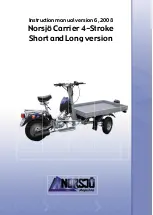
TROUBLESHOOTING AND DIAGNOSTICS
Page O-9
Repair and Service Manual
Read all of Section B and this section before attempting any procedure. Pay particular attention to all Notices, Cautions and Warnings.
B
B
Warning DC Bus Low
DC Bus voltage is less than 24
volts.
1. Verify that all battery wires are securely
fastened and have less than 0.1 ohms resis-
tance between wire terminal and battery
post.
2. Check the battery voltage across all 4 bat-
teries, voltage should read 42 VDC
MINI-
MUM
.
3. Check voltage across solenoid contacts. If
more than 3 VDC but less than 24 VDC pro-
ceed to step 3, if it does not fall in this range
follow
ACTION 3
.
4. Verify power resistor ohm reading is
between 0.2 and 0.5 ohms.
5. Remove resistor control module connec-
tion to controller B- terminal. If error status
changes follow
ACTION 1
.
1. Tighten or replace loose
or high resistance power
wire connections.
2. Replace power resistor.
3. Replace solenoid.
4. Replace resistor control
module.
5. If error continues,
replace the controller.
Warning DC Bus High
Controller DC Bus voltage is
greater than 67 volts.
1. Verify that all battery wires are securely
fastened and have less than 0.1 ohms resis-
tance between wire terminal and battery
post.
2. Check the battery voltage across all 4 bat-
teries, voltage should read 63 VDC
MAXI-
MUM
.
3. Check voltage across solenoid contacts. If
more than 3 VDC but less than 24 VDC pro-
ceed to step 3, if it does not fall in this range
follow
ACTION 3
.
4. Verify power resistor ohm reading is
between 0.2 and 0.5 ohms.
5. Remove resistor control module connec-
tion to controller B- terminal. If error status
changes follow
ACTION 1
.
1. Tighten or replace loose
or high resistance power
wire connections.
2. Replace power resistor.
3. Replace solenoid.
4. Replace resistor control
module.
5. If error continues,
replace the controller.
Warning BDI Calibration
1. The DC Bus measurement
system is not calibrated.
no diagnostic steps to perform
1. Replace the controller
Warning Motor Temp High
1. Measured motor tempera-
ture is greater than 140°C
(284°F) but less than 150°C
(302°F). Linear torque current
reduction is active, drivability is
affected (reduced speed).
1. Check external motor temperature, should
be less than 120°C (248°F).
2. Check thermocouple resistance, should be
more than 400 ohms and less than 1300
ohms, if out of range perform
ACTION 3
.
1. Allow time to cool.
2. Reduce payload or driv-
ing grade.
3. Replace motor.
4. Replace controller.
Warning Motor Temp Sensor 1. Motor temperature sensor is
shorted or not connected.
1. Check external motor temperature, should
be less than 120°C (248°F).
2. Check thermocouple resistance, should be
more than 400 ohms and less than 1300
ohms, if out of range perform
ACTION 3
.
1. Allow time to cool.
2. Reduce payload or driv-
ing grade.
3. Replace motor.
4. Replace controller.
Warning Heat Sink Temp
Low
1. Controller heat sink temper-
ature is less than -20°C (-4°F).
Max torque current reduction is
active, drivability is affected.
This condition normally goes
away after a few minutes of
operation when the heat sink
warms up to a temperature
greater than -20°C (-4°F).
1. Check external heat sink temperature, it
should be more than -20°C (-4°F).
2. If heat sink temperature is greater than
-20°C (-4°F) then see
ACTION 2
.
1. Warm vehicle to greater
than -20°C (-4°F).
2. Replace controller.
CODE
DESCRIPTION
POSSIBLE CAUSES
DIAGNOSTIC STEP
ACTION (post diagnos-
tics)
















































